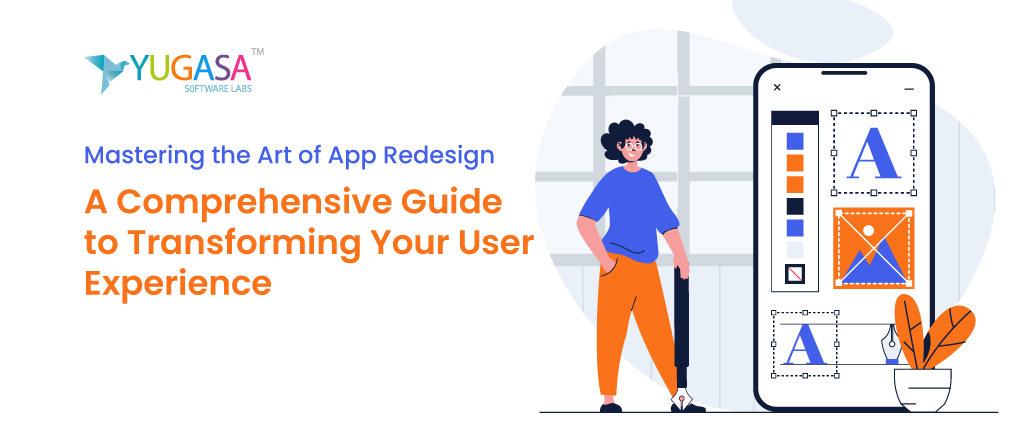Mastering the Art of App Redesign: A Comprehensive Guide to Transforming Your User Experience

Are you interested in enhancing your mobile application? A strategic redesign can significantly boost user experience (UX) and engagement. As mobile apps become increasingly integral to daily life, users expect high levels of usability and functionality. A poorly designed app can lead to user disengagement, dissatisfaction, and negative feedback. Conversely, a thoughtfully designed app can elevate user satisfaction and strengthen brand loyalty.
In this article, we’ll guide you through the steps for a successful mobile app overhaul, covering everything from user research to design implementation and testing.
Top three factors to consider before application redesign
Designing a mobile app for your company can be a transformative step, so it's important to approach it with care. A well-implemented redesign can enhance user experience, boost engagement, and potentially increase revenue. Conversely, a poorly executed redesign can frustrate users, erode customer loyalty, and harm your brand’s reputation.
Creating a successful mobile app involves careful planning, understanding user needs, and aligning with your company's objectives. Before starting a redesign, assess user behavior and feedback, identify pain points and areas for improvement, and develop a solid strategy to address these issues.
Consider these questions:
● What are the goals of the redesign? Are you aiming to boost user engagement, increase sales, or simply refresh the app's design?
● Who are your target users? What are their needs, behaviors, and objectives? Are there any issues with the current app that need addressing?
● What are the strengths and weaknesses of the existing app? What aspects work well and what areas need improvement? What feedback have you received from users?
Reflecting on these questions will help ensure the success of your mobile app redesign project.
Three reasons for an app redesign
● Platform Updates: As mobile platforms and technologies advance, it's crucial to keep your app current. A redesign can ensure compatibility with the latest devices and development frameworks.
Solution: Regularly update your app to align with emerging mobile technologies and optimize it for new development frameworks and devices. This may involve adjusting the design or user experience to enhance compatibility and performance.
● Poor User Experience: If users struggle with navigation or feature discovery, a redesign can enhance usability and make the app more intuitive, which can boost engagement and retention.
Solution: Pinpoint problematic areas such as confusing navigation or a cluttered interface. Simplify the design and user experience to make it more intuitive and user-friendly.
● Outdated Design: A redesign is often necessary if your app's design appears outdated or no longer aligns with your brand or audience. An updated design can refresh the app’s look and improve user engagement.
Solution: Modernize the app’s design to reflect current trends and align with your brand and target audience. Consider using contemporary design elements, color schemes, and possibly engaging a design agency to ensure the app is visually appealing and easy to use.
How to redesign an app? Essential steps to redesigning your app for success
Evaluate Current Design
Start by assessing your app's current design. Identify strengths and weaknesses in usability, aesthetics, and functionality. Collect user feedback and data to pinpoint areas needing improvement. This analysis will guide your strategic redesign decisions.
Set Goals
Establish clear, measurable goals for the redesign. Define objectives like increasing user engagement, enhancing performance, or updating the interface. Ensure these goals align with your company's broader objectives to contribute to overall success.
Research and Ideation
Conduct comprehensive research on user preferences, market trends, and competitor offerings. Organize brainstorming sessions to generate ideas. Explore innovative features and design elements that align with your goals and address user needs identified through research.
Create Wireframes and Prototypes
Develop wireframes and prototypes to outline the new user flow and app structure. Start with low-fidelity wireframes to sketch core functionality and
layout. Progress to high-fidelity prototypes that simulate user interactions and interface dynamics, iterating based on feedback.
Visual Design and Development
Implement graphic design elements that enhance your brand identity and user experience. Focus on appealing visuals, readable typography, and intuitive navigation. Collaborate closely with developers to ensure smooth integration of design elements during the development phase.
FAQs
What impact does user feedback have on the redesign process?
In order to pinpoint problems and opportunities for improvement, user feedback is essential. It offers perceptions into user inclinations and actions, which can direct design choices to improve user happiness and usability.
How can I make sure that my brand identity is reflected in my redesign?
Make consistent use of the visual components, typography, and color scheme of your brand. Make sure the redesign conveys the messaging and values of your brand. If necessary, work with branding specialists to preserve a consistent brand identity.
Final thoughts
Making thoughtful design choices that cater to your app's target audience is crucial for enhancing user experience. In a crowded market, creating an app that stands out requires focusing on delivering a seamless and intuitive user
experience by providing easy access to essential features and staying true to the app's core purpose.
Remember that achieving the perfect design may involve some trial and error. It’s important to be open to iterative improvements.
If you’re looking to improve your app’s user experience, consider partnering with Yugasa Software Labs. As experts in mobile app development, they offer valuable insights into user behavior, helping you identify issues and refine the user interface to maximize engagement and retention.
